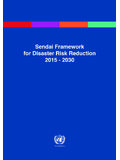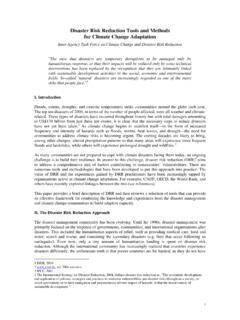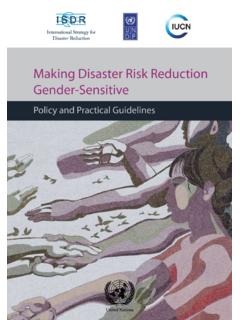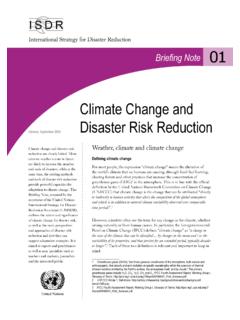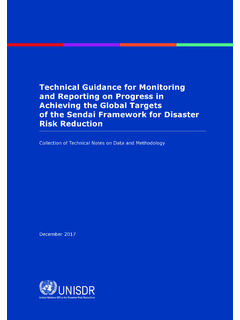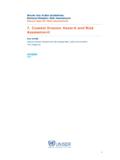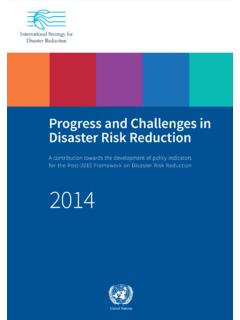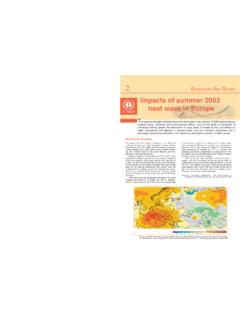Transcription of Build Back Better - United Nations Office for Disaster ...
1 Build back Betterin recovery, rehabilitation and reconstruction2017 | Consultative versionConsultative version Build back Better in recovery, rehabilitation and reconstruction UNISDR 2017 !1 Contents Contents 2 ..Introduction 4 ..Task : Develop an all-stakeholder, national-level Disaster recovery framework 5 ..A. Understanding the task 5 ..What's the purpose of this task? 5 ..Why is it important? 5 ..How does it relate to other priority tasks? 6 ..Terminology 6 ..B. How to do it 8 ..Recommended steps 8 ..Questions to ask 9 ..C. Responsibilities and resources 10 ..Who should be involved? 10 ..What conditions facilitate the task? 10 ..D. Illustrations 12 ..E. Further reading 14 ..Task : Enable pre- Disaster recovery planning among all stakeholders 15.
2 A. Understanding the task 15 ..What's the purpose of this task? 15 ..Why is it important? 15 ..How does it relate to other priority tasks? 16 ..Terminology 17 ..B. How to do it 18 ..Recommended steps 18 ..Questions to ask 20 ..C. Responsibilities and resources 21 ..Who should be involved? 21 ..What conditions facilitate the task? 21 ..D. Illustrations 22 ..E. Further reading 24 ..Task : Formalize processes and systems to enable effective assessment of Post- Disaster damages and needs in order to more accurately quantify and characterize recovery needs and to formulate broad recovery strategies 26 ..A. Understanding the task 26 ..What's the purpose of this task? 26 ..Why is it important? 26 ..How does it relate to other priority tasks?
3 27 ..Terminology 27 ..B. How to do it 28 .. !2 Recommended steps 28 ..Questions to ask 29 ..C. Responsibilities and resources 30 ..Who should be involved? 30 ..What conditions facilitate the task? 31 ..D. Illustrations 32 ..E. Further reading 34 ..Task : Institute or strengthen policies, laws, and programs that promote (incentivize), guide (ensure), and support Build back Better in recovery, rehabilitation, and reconstruction in both the public and private sectors, and by individuals and households 35 ..A. Understanding the task 35 ..What's the purpose of this task? 35 ..Why is it important? 35 ..How does it relate to other priority tasks? 37 ..Terminology 37 ..B. How to do it 38 ..Recommended steps 38.
4 Questions to ask 39 ..C. Responsibilities and resources 40 ..Who should be involved? 40 ..What conditions facilitate the task? 41 ..D. Illustrations 41 ..E. Further reading 43 ..Acknowledgements !3 Introduction Disaster impacted countries and communities are oftentimes much Better equipped to Build back Better during the extended period of recovery, rehabilitation, and reconstruction when they have taken actions to strengthen recovery capacity and decision-making effectiveness prior to the onset of Disaster . As such, implementation of Priority 4b focuses on building this 1capacity through the creation and strengthening of recovery-focused relationships, the establishment of planning and coordination mechanisms, and the introduction of methods and procedures to ensure recovery activities are adequately informed and supported.
5 National-level Disaster recovery frameworks provide the structure and context required by stakeholders active in recovery planning and operations. Pre-event research and planning for post-event recovery ( pre- Disaster recovery planning) helps to identify and address functional requirements and resource needs, and increases the likelihood that risk reduction and sustainable development opportunities are incorporated. Finally, recovery outcomes depend heavily on the existence of programs and mechanisms that support recovery, whether through the provision of human, financial, or other resources, or by promoting, informing, and as necessary, mandating risk-aware, climate-adaptive, and development-focused recovery goals.
6 Stakeholders in Priority 4b, which include national and local governments, the private sector, and civil society organizations, can undertake a number of tasks to implement Priority 4b. This guide recommends the following four tasks: Develop an all-stakeholder, national-level Disaster recovery framework Enable pre- Disaster recovery planning among all stakeholders Formalize processes and systems to enable effective assessment of post- Disaster damages and needs in order to more accurately quantify and characterize recovery needs and to formulate broad recovery strategies Institute or strengthen policies, laws, and programs that promote (incentivize), guide (ensure), and support Build back Better (BBB) in Recovery, Rehabilitation, and Reconstruction (RRR)
7 In both the public and private sectors, and by individuals and households Priority Four of the Sendai Framework has been divided into two separate efforts for 1development of the WiA guidance. Therefore, recognizing the WiA guide for Enhancing Disaster preparedness for effective response as the first part of the Priority Four (4a), this WiA guide as 4b focuses on Build back Better in recovery, rehabilitation, and reconstruction. !4 Task : Develop an all-stakeholder, national-level Disaster recovery framework A. Understanding the task What's the purpose of this task? This task focuses on bringing together the country s diverse community of Disaster recovery stakeholders in order to establish a common all-hazards Disaster recovery framework to Better manage pre- and post- Disaster planning and operations.
8 Performance hinges on the ability of stakeholders to collectively identify, analyze, and document the parameters within which recovery effectiveness and efficiency are maximized at all government levels and by all stakeholder groups (including businesses, nonprofit organizations, communities, households, and individuals). Through framework development, intergovernmental and inter-organizational relationships, roles, and responsibilities are clarified, and common recovery goals, objectives, and vision statements are documented. While Nations frameworks may vary in their structure and design, their basic function is to define stakeholder relationships, clarify recovery phases and timelines, provide information on transitioning from relief to recovery, and explain how recovery operations are concluded.
9 Governments can use the recovery framework to explain recovery support programs, and to communicate information regarding factors key to effective and efficient recovery. Why is it important? Recovery is the most complex of the Disaster management functions, involving the greatest number and variety of stakeholders and affecting the greatest long-term impact on a community s social and economic success. There are numerous relationships that must be formed and dependencies that must be fostered, many of which are wholly unfamiliar to the recovery stakeholders that typically operate outside of the post- Disaster context. An inclusive and comprehensive Disaster recovery framework serves as an agreed way forward to simplify the recovery process thereby maintaining or even improving development trajectories while ensuring adherence to Build back Better principles.
10 Recovery is most successful when the wide-ranging needs of communities, organizations, and individuals are addressed in the coordinated manner that recovery frameworks enable. Disaster recovery frameworks are thus necessary to ensure an adequate structure for and linkages between the systems, strategies, and plans which !5arise in the post- Disaster setting. The diverse community of recovery stakeholders involved in both pre- and post- Disaster recovery planning look to national-level frameworks to Better understand roles and responsibilities and for guidance on developing recovery goals, objectives, and measures for success. Moreover, the presence of a recovery framework enhances awareness and adoption of common recovery principles deemed critical to positive recovery outcomes, articulates a shared sustainable recovery vision, and enables prioritization and sequencing of recovery activities.
